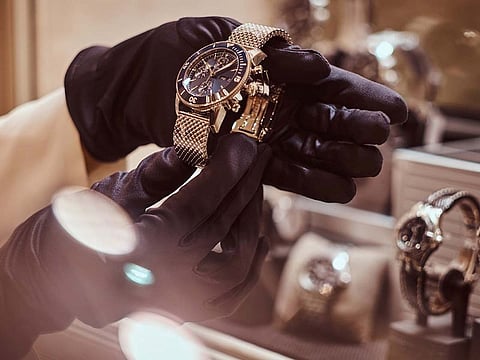Luxury watches now better than gold for UAE buyers? Investment values surge
UAE investors see rising value in collectible luxury watches as demand and prices surge

Dubai: Luxury watches are no longer just style statements in the UAE — they’re turning into serious investment assets.
As inflation, market volatility, and currency fluctuations reshape global wealth strategies, UAE buyers are increasingly viewing timepieces from Rolex, Patek Philippe, and Audemars Piguet as both symbols of prestige and stores of value.
In an era marked by inflation, volatile equities, and currency swings, investors are turning to tangible investments that hold value. Luxury timepieces have proven profitable, with global indices tracking pre-owned watch prices showing long-term appreciation even after a brief correction in 2023.
Growing global market
According to Statista, global revenue in the luxury watch market is projected to reach US $63.7 billion in 2025 and expand at an annual rate of 3.8 % through 2030.
Research from MarkNtel Advisors places the market at US $53.9 billion in 2024, with expectations to climb to US $72.9 billion by 2030 — a growth rate of more than 5 % annually.
Asia-Pacific leads this growth, driven by rising disposable incomes and a younger generation that increasingly views collectible watches as both wearable art and financial assets.
In markets like India, luxury watch sales are expanding by over 11 % annually, while the UAE remains one of the top destinations for Swiss watch exports, according to the Federation of the Swiss Watch Industry (FH).
Growing interest in UAE
In October 2025, European asset manager Timetrade Investments set up operations in Nad Al Sheba, Dubai, citing the UAE’s high concentration of wealth and growing appetite for alternative assets.
According to New World Wealth, Dubai now counts more than 86,000 millionaires, 251 centi-millionaires, and 23 billionaires — a base that has helped make it one of the world’s top five cities for luxury-asset investment.
The emirate’s open trade policies, tax advantages, and access to regional and international buyers have also positioned it as a natural hub for watch collectors and investors. Retailers in Dubai Mall’s dedicated watch precincts report rising interest not only from buyers but also from collectors seeking appreciation potential, according to Chrono24 and WatchCharts data.
What drives watch values
Timetrade’s founder, Daniel Niels Nielsen, points to three main factors behind long-term price growth:
Limited supply: Top brands deliberately restrict production to maintain exclusivity. Rolex, for instance, produces an estimated one million watches a year, but global demand far exceeds that.
Growing demand: Rising global wealth, especially in Asia and the Middle East, continues to push demand for collectible timepieces. The UAE, Saudi Arabia, and Qatar together account for more than 8 % of global Swiss watch imports, as per FH data.
Rising list prices: Inflation and higher production costs have lifted retail prices across most major brands, which in turn boosts pre-owned values.
Where investment appeal is
Market data from WatchCharts shows that despite a mild correction since 2023, the average value of top-traded luxury watches remains over 30 % higher than pre-pandemic levels. Certain models — such as the Rolex Daytona, Patek Philippe Nautilus 5711, and Audemars Piguet Royal Oak — have retained or regained much of their pandemic-era surge in value.
Analysts describe the correction as a “healthy normalization” that has shifted the focus from speculative flipping toward longer-term holding and collecting. According to Morgan Stanley and LuxConsult, the top five Swiss brands now control nearly 60 % of global market value, underscoring how brand concentration strengthens long-term pricing power.
UAE investors, consider this
Diversification: Luxury watches can complement property, equities, and gold in a diversified portfolio, offering tangible security and a hedge against inflation.
Liquidity: The secondary market — supported by digital platforms and auction houses — provides relatively fast resale options, with estimated turnover of US $25 billion globally.
Costs: Investors must factor in servicing, authentication, and insurance, which can reduce net returns.
Market access: Dubai’s role as a free-trade hub offers advantages for authentication, logistics, and resale, particularly for watches sourced from Europe or Asia.
Bigger picture..
The global luxury watch market is changing fast. Brands are using new technology like blockchain for authentication, turning to recycled materials, and creating designs that mix tradition with innovation.
For UAE investors, the message is clear — luxury watches aren’t just for collectors anymore. They’ve become a serious, data-backed investment. In a region where portfolios often include property, gold, and art, watches are now emerging as the next tangible way to diversify and protect long-term wealth.
Sign up for the Daily Briefing
Get the latest news and updates straight to your inbox




